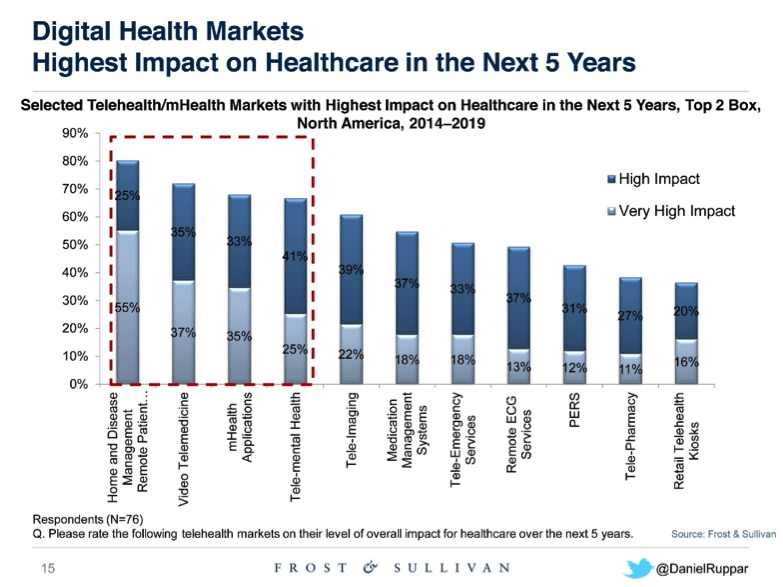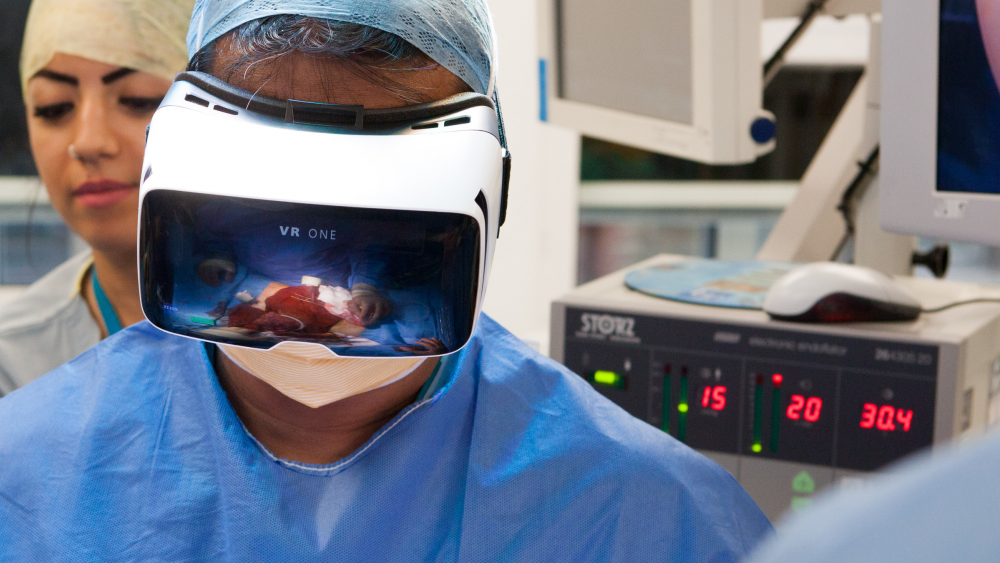The healthcare challenge: do it well, do it more, and be frugal about it. If there’s any sector in healthcare that’s up to that challenge, it’s the old hat of telemedicine—that’s suddenly sprouting new wings to expand the array of options to provide quality, accessible and affordable care.
With new support initiatives rolling in from governing bodies, and reports predicting massive growth, telemedicine is riding a wave of momentum that may change healthcare delivery forever. Here, we’ll take a look at what industry leaders and technology experts are predicting in this exciting field over the next half decade.
Industry Leaders
At the Digital Health Summer Summit 2014, Daniel Ruppar, Director of Research for Frost & Sullivan, presented findings of a recent survey of industry stakeholders in “Pulse of Telehealth 2014: Stakeholder Views on Telehealth from the American Telemedicine Association (ATA) Annual Meeting.” In it, respondents provided Voice of Market predictions that the following specific telehealth and mhealth markets will have the highest impact on healthcare over the next five years, in order of priority:
1. Home and Disease Management/Remote Patient Monitoring
2. Video Telemedicine
3. mHealth Applications
4. Tele-mental Health
5. Tele-Imaging
6. Medication Management Systems
7. Tele-Emergency Services
8. Remote ECG Services
9. Personal Emergency Response Systems (PERS)
10. Tele-Pharmacy
11. Retail Telehealth Kiosks

Pulse of Telehealth 2014: Stakeholder Views on Telehealth from the American Telemedicine Association (ATA) Annual Meeting. Copyright © Frost & Sullivan. Used with permission.
Ruppar also sat down with Jonathon Linkous, CEO of the ATA, for a Movers and Shakers interview. In it, Linkous noted that there have been ongoing marketplace issues over the last year in terms of telehealth, yet significant progress persists—as seen by the estimated ten million Americans that were served by it in the same period.
“We’re in booming times…the amazing thing is that despite the fact that we have a lot of obstacles…there’s been tremendous growth in telemedicine.”
When asked about a variety of issues, Linkous provided the following key insights:
- Government health policy: At the federal level, Medicare needs a major overhaul, since it’s out of step with what’s going on in technology in the 21st century. On both the regulatory and provider sides, there is agreement for the need to move from a fee-for-service model, with a preference for managed care and capitated care – since that model aligns with the benefits of telemedicine—improving quality, expanding care and reducing costs.
- Leading market opportunities: Growth in remote monitoring will be significant, since an aging population and increase in chronic disease creates more “frequent flyers” who are using the emergency room and hospitals extensively. In order to address this need and help patients stay in their homes as much as they want to be, remote monitoring will be a growing solution—especially since consumers have an increased interest in using technology.
- Other telemedicine opportunities: Telemental health is predicted to be one of the top four areas in telehealth—and the ATA has guidelines for this specialty. Telepharmacy is being used a lot in rural settings—but is also impacted by pharmacy laws. However, with the shortage of providers and high levels of complications associated with medications, this is predicted to be an area of rapid growth in telemedicine in the next five years.
- Consumer-generated data from a variety of sources: Wearables are a bit more hype than reality at the moment, and the degree of success and impact in this area is yet to be seen. Key factors will be consumer acceptance, continuity of use, and how the data will be integrated into the consumer’s care. Consumer-generated data via technology is not necessarily interoperable, and the real question will be how it can be integrated into the EHR and clinical IT systems.
- Telemedicine and the EHR: The ATA is seeing a change in the way telemedicine is viewed by EHRs. Where it used to be seen as outside of the typically hospital-based EHR, it now is being recognized as having the ability to break down the walls of hospitals to be present with patients wherever they are. “It’s an amazing time that we live in. People talk about how the future of delivery of care may sometime be changed. I think it’s already changed.”
A Vendor’s Perspective
On the vendor side, in an interview for Healthcare Informatics, Microsoft’s chief health strategy office, Dennis Schmuland, M.D., says that in order to make the shift from volume-based to value-based care, healthcare is looking to technologies such as telemedicine that support a patient-centric model of care, instead of one that puts providers in the center.
“We are now in this era of frugality and growing prevalence of chronic disease and a continuum-based payment model. The focal purpose of technology is to improve health, improve outcomes and the experience of care for more patients securely, in less time and at a lower cost.”
He says that translates to collaborative teams that are mobile and work across the boundaries of healthcare organizations and disciplines—with telemedicine increasingly being viewed as a means of achieving such a model of “care delivery without walls.”
Noting that about half of the 900 million doctor visits each year could be done virtually—he views those that are visual or conversational by nature as the low hanging fruit that can help fill the gap for access to providers:
“Care delivery without walls is a way of addressing those supply-and-demand imbalances, because expertise isn’t always available where the need exists in the U.S.”
Infrastructure Needs
As a foundational need for telemedicine, connectivity is also being addressed. Though the Federal Communications Commission (FCC) is not a healthcare entity, it holds a critical influence over the infrastructure which is essential to telemedicine’s success: broadband connectivity for rural providers.
That’s why the recent announcement that 76 new consortia have applied for funding under the FCC’s Healthcare Connect initiative has been so exciting. The Healthcare Connect Fund (HCCF) was created to expand access by healthcare providers (HCPs) to “robust” broadband networks in order to improve the quality and reduce costs of healthcare in rural areas, expanding the benefits of telemedicine nationwide. According to Matt Quinn, director of healthcare initiatives at the FCC,
“Telemedicine, it’s coming. FCC doesn’t deliver or reimburse for care and we’re not involved in licensure. We understand that once those barriers are knocked down there are going to be connections that need to be made or upgraded. Today, many networks are hub and spoke. In time, (providers) are going to make the best use of those networks for things like Big Data, analytics, telemedicine, that they aren’t really structured for today.”
Do it well. Do it more. And be frugal about it. With the sudden outpouring of support from a variety of sectors across healthcare, Telemedicine is up to the challenge—and ready to show the rest of the world exactly how it’s done.
Log in or register for FREE for full access to ALL site features
As a member of the nuviun community, you can benefit from:
- 24/7 unlimited access to the content library
- Full access to the company and people directories
- Unlimited discussion and commenting privileges
- Your own searchable professional profile







.jpg)
